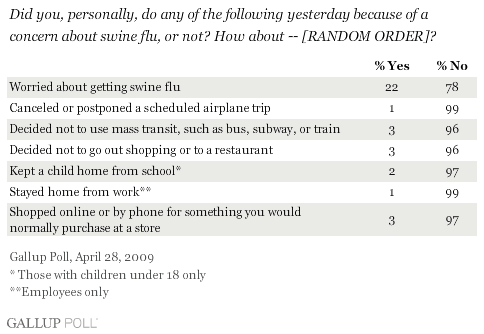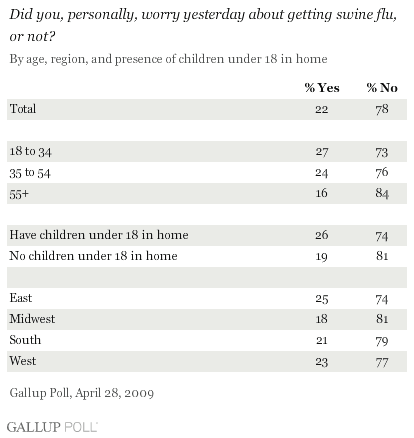PRINCETON, NJ -- Although 22% of Americans report worrying about getting swine flu, there appears to be only minimal impact on the public's daily behavior so far, despite extensive news coverage about the virus and its potential spread. A ���۴�ýPoll conducted Tuesday night shows that just 1% to 3% of Americans say they decided not to go shopping or go out to a restaurant, canceled an airline trip, decided not to use mass transit, stayed home from work, or kept a child home from school because of concerns about swine flu.

The ���۴�ýPoll was conducted Tuesday night, April 28. While 22% of those interviewed reported they personally worried about getting swine flu "yesterday," the incidence of worry varies among demographic and regional subgroups of the population:
-
Americans 55 years of age and older are slightly less likely to worry than those who are younger, reinforcing Gallup-Healthways data showing that .
-
Those with children under 18 in the home are slightly more likely to be worried than those who don't have children in the home.
-
Worry is slightly less prevalent in the Midwest than elsewhere.

Although the sample size of Hispanics in the poll is too small to provide reliable estimates, the data suggest that Hispanics are considerably more likely than non-Hispanics to worry about getting swine flu. Given that the swine flu epidemic apparently originated in Mexico, and that most of the reported deaths have occurred there, this connection is understandable.
The ���۴�ýdata indicate that the swine flu situation has not caused major shifts in Americans' behavior so far, at least based on self-reports. The poll asked Americans whether they had -- as a result of concerns about swine flu -- changed their behavior "yesterday" in several different ways. Very small percentages of Americans replied in the affirmative for each behavior measured.
Certainly even 1% of the population can be a significant group of people if extrapolated to the overall adult population of roughly 220 million. But very low percentages such as these, as recorded in random-sample surveys, must be interpreted with caution. The survey in which these data were obtained involved interviews with 1,021 individuals and, as is true with any survey, the results of each question are an estimate of the underlying population that carries with it a margin of sampling error. Experience also indicates that there will be a small percentage who respond in the affirmative to almost any survey question, regardless of the question.
It is thus a reasonable interpretation to say that the survey results point to an estimate of behavioral change among the adult population that is quite minimal as a result of swine flu concern. (At the same time, it is important to realize that the scope of these questions was limited to changes in behavior "yesterday," and the percentages may be higher if Americans are asked to report on their behavior over a longer time span.)
These data provide an important baseline measure of public reaction to the swine flu outbreak, and ���۴�ýwill update the estimates of changes in these behaviors in the coming days.
There are minor variations by region in response to these behavioral indicators. Those living in the West are somewhat more likely than those living elsewhere to say they decided not to go out shopping or to a restaurant as a result of concern over swine flu. Future surveys will show whether behavioral change as a result of swine flu continues to appear higher in the Western region of the country.
Survey Methods
Results are based on telephone interviews with 1,021 national adults, aged 18 and older, conducted April 28, 2009, as part of ���۴�ýPoll Daily tracking. For results based on the total sample of national adults, one can say with 95% confidence that the maximum margin of sampling error is ±3 percentage points.
Interviews are conducted with respondents on land-line telephones (for respondents with a land-line telephone) and cellular phones (for respondents who are cell-phone only).
In addition to sampling error, question wording and practical difficulties in conducting surveys can introduce error or bias into the findings of public opinion polls.
Polls conducted entirely in one day, such as this one, are subject to additional error or bias not found in polls conducted over several days.
